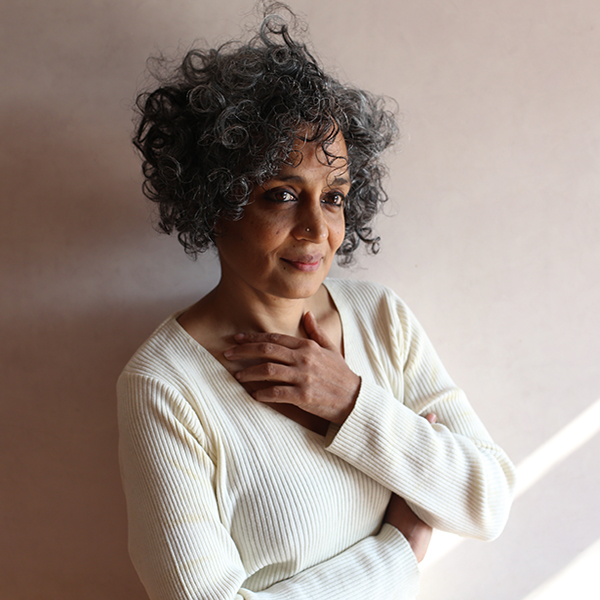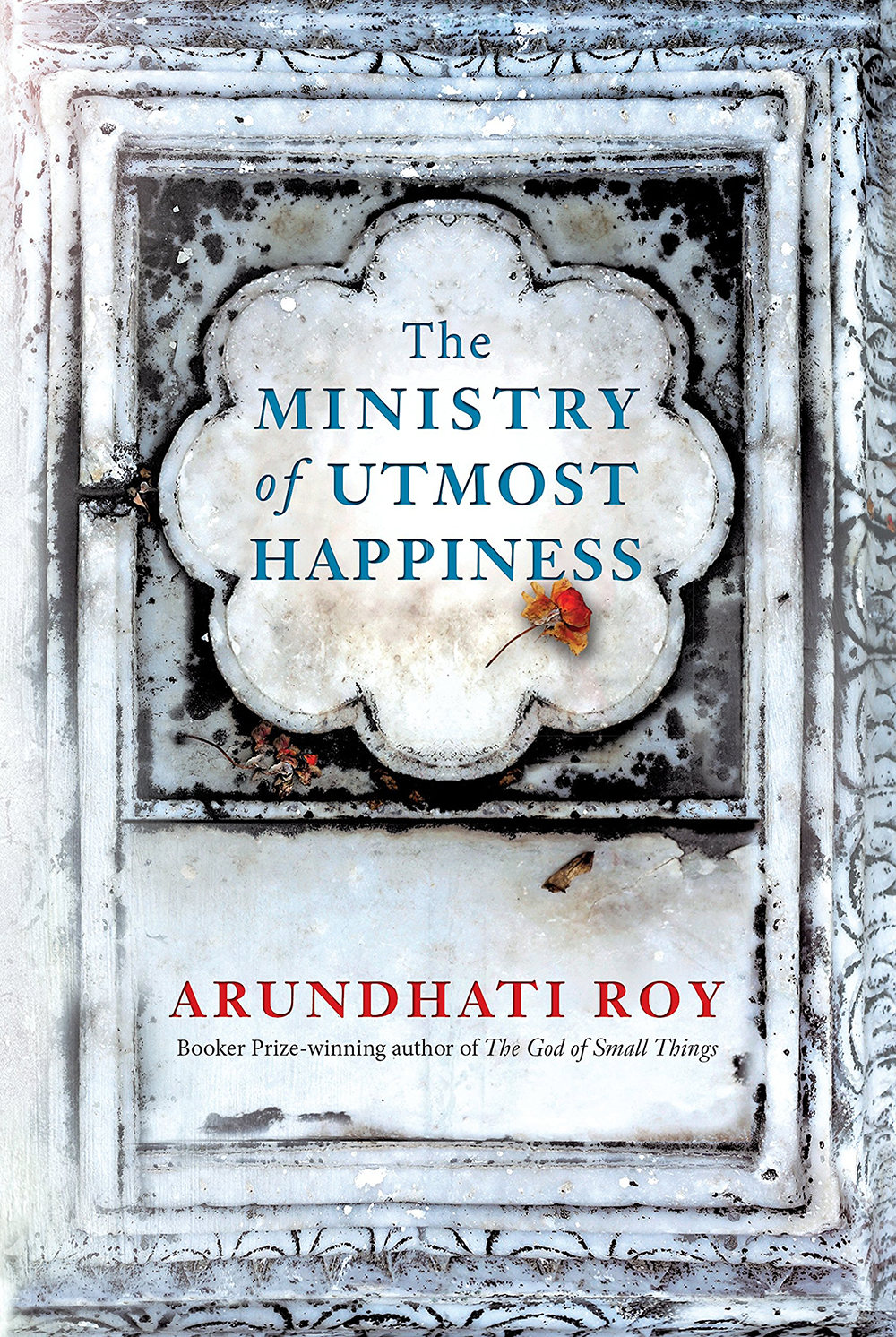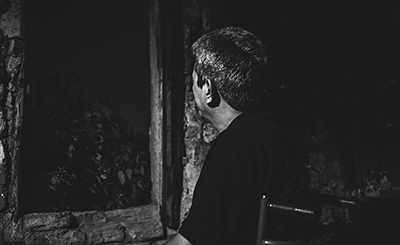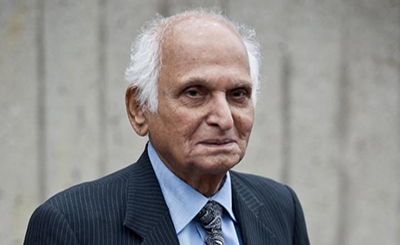
Arundhati Roy. Photo courtesy of Penguin Random House India
In The Ministry of Utmost Happiness,
Roy challenges the format of the novel
One of the traditional prescriptions for writing lasting fiction, authenticated, among others, by Anton Chekhov, is to keep politics at length out of the pages.
Writers like Jorge Mario Pedro Vargas Llosa — The Feast of the Goat, a portrait of a despot — have occasionally gone against this recipe of cooking fiction. Hemingway’s For Whom the Bell Tolls which, to my mind, is a political novel that is saved from its own implosive, didactic attitudinising by sheer strength of characterisation and details of the drama.
More recent political novels include Freedom by Jonathan Franzen, a novel about America as it confronts the beginning of the sea changes that that 20th century brings and its impacts on a particular family. Aravind Adiga’s The White Tiger is another well-paced political novel. There are others, I am sure, that I don’t know about.
Despite Chekhov then, the political novel is an active animal. Recently, Zoe Williams said fiction is a luxury when reality is too pressing. She, therefore, advocated non-fiction.
I do not subscribe to that view. I believe there is space in fiction for non-fiction; but it’d be self-defeating if non-fiction has its share of fictive elements.
Arundhati Roy’s long-awaited second novel, The Ministry of Utmost Happiness, is rooted in reality. Especially in Indian reality. It is a teeming, rich, decaying reality; a majestic but rotting corpse faintly breathing; the kind of reality that is hard to distinguish from the comic if morbid imagination. Magic and mayhem await around every corner. The odds favour the improbable. The average Indian’s acceptance level of magic, even black magic, is high. Even a deformed cow, or a strange-shaped tree, could endorse it.
Since just about everybody seems to have reviewed The Ministry, I would only sum up the book as the map of India’s massive shift in emphasis from a reasonably secular, chaotic but democratic history and geography, to a clearly defined Hindu nation, a purity of race concept that empowers the “normal” Hindu to thump his chest at the prospect of believing bloodily a monolithic Cause, whose ways of assertions could include the seemingly harmless folklore, or the direct bullying by a political party that derives its righteousness — even to kill — from ancient myths.
The Cause is both godly and imperial in its dimensions. It’s a certified way of life. This is not an easy thing to achieve in these fraying times. In India the Cause is the unity and consolidation of the Hindus as well. How can you not believe in it if you are a Hindu? If you are an Indian, why are you not a Hindu?
Roy’s novel is about that; and not. The reason for that ambiguity lies at the bottom of the basic ironies guiding the narrative. Kashmir, a central fulcrum of the novel, comes across as a puzzle India must figure out, both in terms of its militancy and its militant excesses. How do you deal with religious nationalism in a country that is not quite aghast at the possibility that it is an oppressor? When did the victim turn a tyrant?
The secular part of the narrative is where Roy’s heart is: the world of the marginalised Muslims, further marginalised by gender and sexuality, the world of the fringe elements, and their shambles of a ministry. In between somewhere, comes the ubiquitous cow, the new animal of terror, divine to the majority, biryani to the minority.
The material of the novel then, as you can see, is plagued by the immediacy of its setting. It is what is happening. What Roy has done for the most part is merely copy-paste the reality she is living day in and day out. There is a reason for it, perhaps even a deliberate, calculated quality to the project she has undertaken. As Tilo in the book says: “I would like to write one of those sophisticated stories in which even though nothing much happens, there’s lots to write about… That can’t be done in Kashmir. It’s not sophisticated what happens here. There’s too much blood for good literature.”
I assume Roy is serious about her pronouncements. Because to read this in one uncharitable way is to say that Roy is bent on writing poor literature, redeemed possibly by the truth that it represents. Wallace Stegner says somewhere (in words to that effect) that truth is a fine thing, and that you must treat it as delicately as an eggshell. That sounds simple, but it demands a sense of balance that is hard to achieve, especially when you are writing a political novel in which the richness of the reality deludes you into believing its reproduction is as good as recreating it in words.
The trouble is that she has chosen a format that resists truth naturally. Fiction is a lie. And that lie has to come across as a truth. This is of course easier said than done. But the fact that Roy knew the dangers attendant on her choice of narration and emphasis are what makes for me a beguiling work; beguiling because The Ministry’s ultimate objective is not only to question the “Nationalist” narrative, but also to self-destruct the myth of Roy herself as a novelist burdened with the task of representing the rights of the underprivileged in fiction. Perhaps this is a self-styled role. But in practice it makes no difference: Roy is serious about destroying her persona as a novelist and has opted for the role of the activist.
The friction of that conflict is evident throughout the book. For instance, the whole idea of seeing magic in the most ordinary things like a horse being ridden through a crowded bylane in Old Delhi. If it is indeed meant to be magical, it comes across as a forced effort at painting squalour pretty. Like romanticising rot. It’s a desperate attempt on the part of the author to impart hope, a flimsy mythical dimension to despair; a last resort of sorts to stay on the side of fiction even as Roy’s writer persona senses the reality is crowding in on her inescapably.
The only way I could interpret Roy’s extended treatise as a novel is if one reads the entire work as a series of extended ironies that finally dissolves the novel into a naturalistic listing of India’s political problems in relation to Kashmir. Admittedly, that doesn’t quite make it first rate fiction. And it has a Borgesian collateral damage: the dissolution of the novelist herself. Of this, later.
The contemporary history of India is so rich in ironies that one would find it difficult to unravel the truth which is at their operational centre. As I write this, there is the abysmal news that Junaid, a boy aged 16, has been roughed up and finally stabbed to death on a train by a bunch of Hindus because they believed he, along with his brother, were beef-eaters. The incident shows the depth to which the at once comic and brutal actors — as in a Stoppard or Pinter play — of Ram’s Caliphate have descended, and the proportionate ascent of the quasi-religious but evolutionary impossibility of the cow as their mother.
Apart from the fact that the boys are Muslims, there is no reason why this need have happened. And this is not the first of such incidents. In the last three years since Narendra Modi has come to power, the very many lynchings this country has seen on account of the cow should equal the toll in a minor war.
But how to turn this real incident into fiction? All the fictive elements of the imagination are already ironically at work in the murder of Junaid. From taking a ticket to fate guiding the two children to a particular compartment, the fact they have nothing to do with cow or bull, Junaid’s last journey would be fiction even for the murdered boy, had he come back to listen to it. It is unreal.
The matrix of Roy’s novel is made of incidents like this which happen now on a weekly basis. Since it is nearly impossible to improve upon the fictional qualities of the Indian reality, Roy’s method could be charitably interpreted as material to work against as much as with, and in that friction and fluidity, bring out the ironies abounding in the texts available even as newspaper reports. But the purpose of the method, as I see it, is not fiction so much as the dispensability of the form itself, as an extra-textual effort to connect with the reality between the covers — which ironically is no different from what’s available outside.
The novel has been described as “hideous” and “beautiful” by Jerry Pinto, and “miraculous” at its best, by Nilanjana Roy and a “ fascinating mess” by The Atlantic. The Irish Times trashed The Ministry, The New Yorker began with praises and then politely distanced itself from the enterprise. Most critics attempted a balancing act out of respect for Roy’s considerable writing talents and her past achievements.
It is a measure of the quality of criticism as an art in our days that we very often are writing about the personality of the novelist rather than the novel itself. We read her into her work. What is criticised is the media-myth, not the work as it is. That goes for the publishing world too. If anyone else had written The Ministry, it most likely would not have seen the light of day.
I do not think The Ministry is either hideous or beautiful. I do not believe for a moment that the book is a ‘miraculous’ work of art, an adjective closely associated with other worldly interventions, an act that defies logic. These adjectives do not confront the problematique that the book offers.
The real problem to my mind — and perhaps the crucial component of the reader’s challenge — is that despite a few adept stabs at satire, the treatment that Roy probably intended, one of awful, endless ironies, does not come across as a sharable trauma. Or drama. That is how the novel fails. But perhaps that is also its success. The complicating factor, as her quote above shows, is that she may not have intended the fictional aspects to get the better of her. She resists the material to be turned into what it’s not: a lie.
Characters like Anjum, who falls clearly beyond the binary gender options and, by extension, the formulaic existential choice paradigm of this or that, either or, are a third sufferance of reality that accommodates, despite the pain and humiliation it engenders, the complexities of the mob — which when it picks on an individual invariably turns him/her into an outsider; the possibility that the fringe offers a fashion forward, and in a hoped-for reversal, turns out to be the new Mother India. An organism of suspect sexuality and splendid squalour; a Bharat Mata of different order, and odour.
But Anjum comes across as too cute an object. A spectacle in ritualistic action, whose conflicts are expropriated by the writer in an effort to lend articulation to the character on her behalf by means of long descriptions. This could be put down to Roy’s ideological identification with Anjum.
The other heroine S. Tilottama or Tilo, a post-modernist witness to the closest that post-Independent India has come to a revolution — Kashmir — is cute, pretty and passive in her passion for a Kashmiri activist, Musa. She bears witness, unable to change history, much like the novel itself, which is why it is one for the record rather than the figment that the fiction predicates on.
Between these two women and three other main male characters the novel doesn’t develop so much as describe what it sees. And what it sees mostly is what the readers are used to seeing outside the book, too. Roy, a constant darling of the upper-class liberal India, and the clueless — when it comes to subcontinental literature— Anglo Saxons (the white Brahmins) who form the crux of the global literary establishment had extended patronage to Roy for close to 20 years. Her cause to a great extent is their cause. It is the cause of the ‘civilised’ values. It is with some grief that they have admitted Roy’s Great Indian Novel is far from the stuff of celebration they had long planned for.
Page
Donate Now
Comments
*Comments will be moderated
What a literary review should be. Kudos!
Anil Menon
Feb 24, 2024 at 22:51












